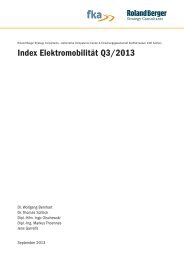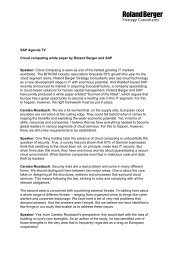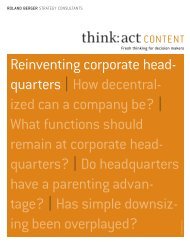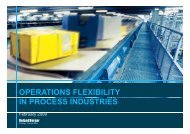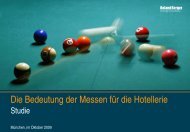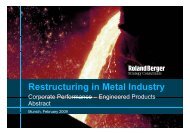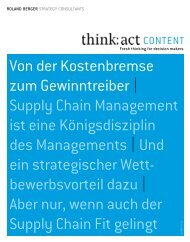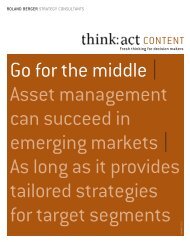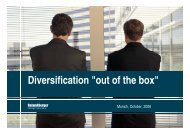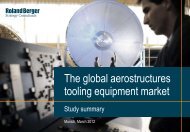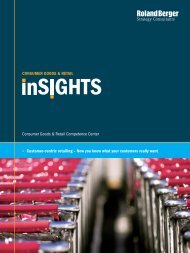"Automotive inSIGHTS 2/2010" (PDF, 3784 KB - Roland Berger
"Automotive inSIGHTS 2/2010" (PDF, 3784 KB - Roland Berger
"Automotive inSIGHTS 2/2010" (PDF, 3784 KB - Roland Berger
Create successful ePaper yourself
Turn your PDF publications into a flip-book with our unique Google optimized e-Paper software.
pOWERTRAINS AND FUELS<br />
OF THE FUTURE<br />
Thesis 8 – A renewable energy mix will promote electric<br />
vehicles<br />
CO 2 emissions of EVs/PHEVs depend on the generation<br />
mix. Renewable and nuclear energy provide the most<br />
reduction potential. In order to improve the well-to-wheel<br />
CO 2 effect, an increase in clean electricity generation is<br />
required. A wind-energy powered electric vehicle emits<br />
83% less CO 2 than a gasoline vehicle. Electricity generated<br />
from renewables is expected to increase by 3.6% p.a. and<br />
account for around 23% of global electricity generation<br />
resources by 2020.<br />
Thesis 9 – Hydrogen may be an option in the future<br />
After the hydrogen hype of the 1990s (when it was considered<br />
the only solution for reducing emissions), today<br />
it is merely a niche application. However, fuel cells for<br />
automotive applications are still being developed. Using a<br />
hydrogen fuel cell as an electric energy source also means<br />
electric driving. Fuel cells are complement battery-powered<br />
electric vehicles and will benefit from their development.<br />
The zero-emission hydrogen car could contribute to sustainable<br />
mobility in the medium to long term.<br />
Thesis 10 – All solutions will contribute to sustainable<br />
mobility<br />
In the future, individual road transport must be environmentally<br />
friendly, otherwise it has no chance of survival.<br />
The environment and the economy are closely involved in<br />
bringing efficient new technologies onto the market. Today,<br />
there is no single, ideal road to sustainability. All reasonable<br />
technological options have to be considered both<br />
for the existing fleet and new vehicles. The innovation<br />
race will ensure that the best technologies will ultimately<br />
shape sustainable mobility in the future.<br />
Dr. Thomas Schlick<br />
Partner,<br />
<strong>Roland</strong> <strong>Berger</strong> Strategy Consultants, Frankfurt<br />
thomas_schlick@de.rolandberger.com<br />
23



